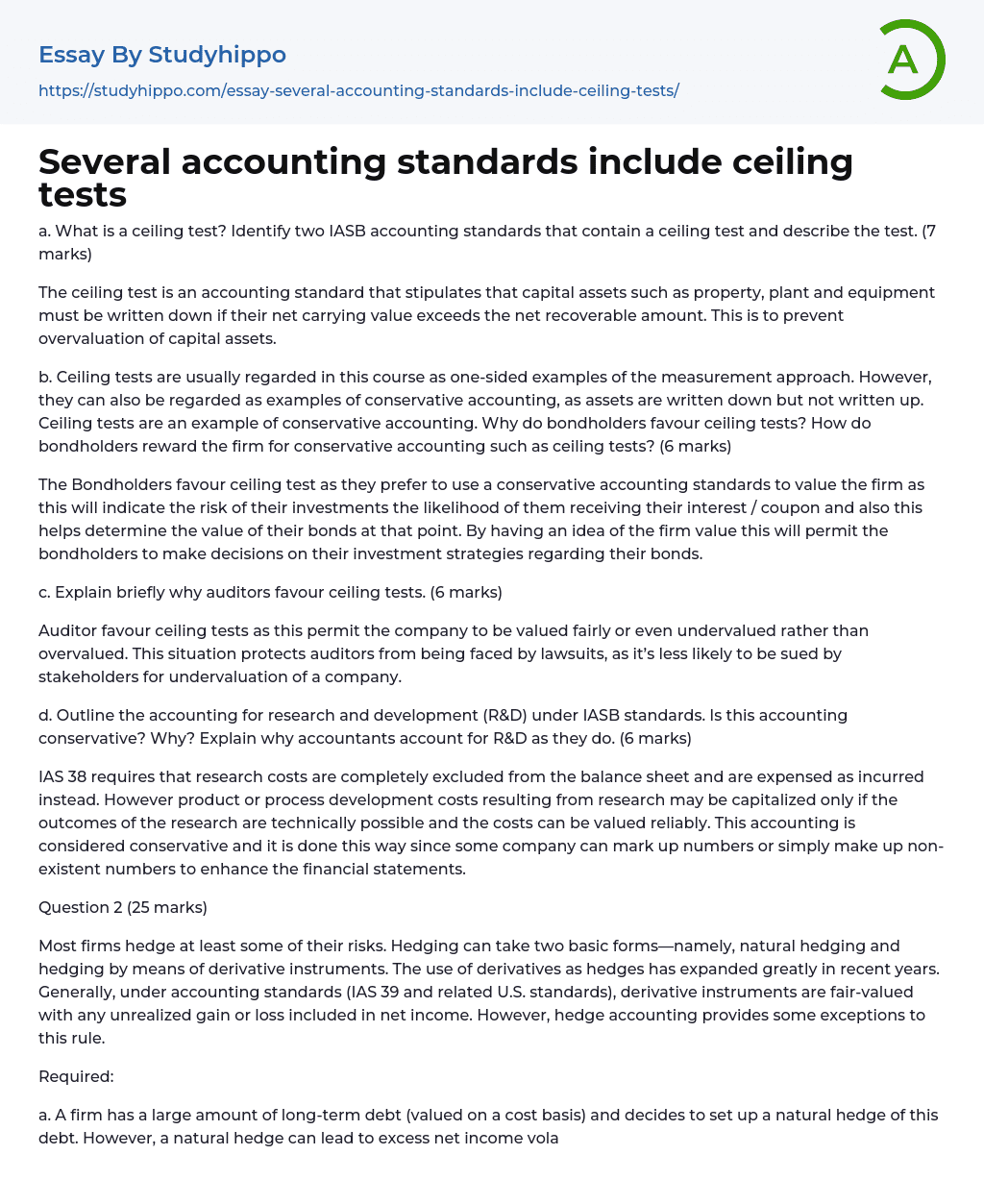

Several accounting standards include ceiling tests Essay Example
a. What is a ceiling test? Identify two IASB accounting standards that contain a ceiling test and describe the test. (7 marks)
The ceiling test is an accounting standard that stipulates that capital assets such as property, plant and equipment must be written down if their net carrying value exceeds the net recoverable amount. This is to prevent overvaluation of capital assets.
b. Ceiling tests are usually regarded in this course as one-sided examples of the measurement approach. However, they can also be regarded as examples of conservative accounting, as assets are written down but not written up. Ceiling tests are an example of conservative accounting. Why do bondholders favour ceiling tests? How do bondholders reward the firm for conservative accounting such as ceiling tests? (6 marks)
The Bondholders favour c
...eiling test as they prefer to use a conservative accounting standards to value the firm as this will indicate the risk of their investments the likelihood of them receiving their interest / coupon and also this helps determine the value of their bonds at that point. By having an idea of the firm value this will permit the bondholders to make decisions on their investment strategies regarding their bonds.
c. Explain briefly why auditors favour ceiling tests. (6 marks)
Auditor favour ceiling tests as this permit the company to be valued fairly or even undervalued rather than overvalued. This situation protects auditors from being faced by lawsuits, as it’s less likely to be sued by stakeholders for undervaluation of a company.
d. Outline the accounting for research and development (R&D) under IASB standards. Is this accounting conservative?
Why? Explain why accountants account for R&D as they do. (6 marks)
IAS 38 requires that research costs are completely excluded from the balance sheet and are expensed as incurred instead. However product or process development costs resulting from research may be capitalized only if the outcomes of the research are technically possible and the costs can be valued reliably. This accounting is considered conservative and it is done this way since some company can mark up numbers or simply make up non-existent numbers to enhance the financial statements.
Question 2 (25 marks)
Most firms hedge at least some of their risks. Hedging can take two basic forms—namely, natural hedging and hedging by means of derivative instruments. The use of derivatives as hedges has expanded greatly in recent years. Generally, under accounting standards (IAS 39 and related U.S. standards), derivative instruments are fair-valued with any unrealized gain or loss included in net income. However, hedge accounting provides some exceptions to this rule.
Required:
a. A firm has a large amount of long-term debt (valued on a cost basis) and decides to set up a natural hedge of this debt. However, a natural hedge can lead to excess net income volatility—that is, net income volatility greater than the actual volatility of the firm’s operations. Explain how this can happen. (5 marks)
This can happen in the case of mismatch. It happens when some assets or liabilities are fair valued but connected liabilities or assets are not fair valued. When firms hold long-term debt with fixed interest rates and may also hold fixed interest bearing securities of similar amount and maturity.
If the interest rates vary the fair value of the interest bearing securities will also vary in the opposite side but the loss or gain will be offset by the debt fair value of variations. The offset won’t be included in the net income but if incurred unrealized gains / losses of the securities will be included but not the long-term debt carried at amortized cost. These situations overvalue the volatility of net income compared to the actual natural hedging volatility.
- Accounts Receivable essays
- Auditor's Report essays
- Balance Sheet essays
- Costs essays
- Financial Audit essays
- International Financial Reporting Standards essays
- Tax essays
- Accountability essays
- Cash essays
- Principal essays
- Management Accounting essays
- Internal Control essays
- Accounting Software essays
- Cash Flow essays
- Investing essays
- Asset essays
- Depreciation essays
- Discounted Cash Flow essays
- Foreign Direct Investment essays
- Funds essays
- Internal Rate Of Return essays
- Revenue essays
- Day Trading essays
- Futures Trading essays
- Capital market essays
- Million essays
- Payment essays
- Rate Of Return essays
- Funding essays
- Hedge Fund essays
- Accounting essays
- Andrew Carnegie essays
- Automation essays
- Business Cycle essays
- Business Intelligence essays
- Business Model essays
- Business Operations essays
- Business Software essays
- Cooperation essays
- Cooperative essays
- Corporate Social Responsibility essays
- Corporation essays
- Customer Relationship Management essays
- Family Business essays
- Franchising essays
- Harvard Business School essays
- Harvard university essays
- Human Resource Management essays
- Infrastructure essays
- Inventory essays



